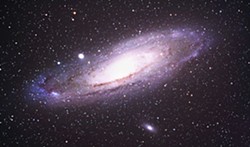[
{
"name": "Top Stories Video Pair",
"insertPoint": "7",
"component": "17087298",
"parentWrapperClass": "fdn-ads-inline-content-block",
"requiredCountToDisplay": "1"
}
]
Looking at the Andromeda galaxy is looking back in time to when Lucy and her forebears roamed the highlands of present-day Ethiopia, making it the farthest object we can see with the naked eye. It consists of a trillion or so stars, the twin to our own Milky Way galaxy, separated from us by a vast ocean of empty space.
How vast? Astronomical distances are measured by how long it takes light to travel from there to here. We see the moon just over a second after light left it. The sun has already moved through its own diameter in the eight minutes it takes its light to reach us. Our entire solar system is just a few light hours across. The nearest star is some four light years away. Light from virtually all the stars we see in the night sky left within the last thousand years. And then there's Andromeda. Light left there two and half million years ago.
One way to visualize that immense distance is to imagine that you're standing a foot away from a rain-spattered glass door staring out at a streetlight half a mile away down the street. The drops on the door represent about the farthest stars we can see without a telescope; they're all in our small corner of the Milky Way. The streetlight stands in for Andromeda, much farther away. When we look at Andromeda, we're seeing way past our local stars out across the gulf of near-nothingness that separates our two galaxies.
Andromeda represents much more than an opportunity to appreciate the most distant object viewable without a telescope. It helped settle one of the greatest scientific debates in history. A hundred years ago, most astronomers thought that the Milky Way defined the universe -- that our galaxy was the galaxy, that is, everything! Then, in 1917, American astronomer Heber Curtis noticed that every one of 12 novae (exploding stars) which had been captured on photos of Andromeda were much dimmer than "regular" novae. He guessed that Andromeda must be much farther away than objects within the Milky Way.
In the famous debate held three years later with fellow astronomer Harlow Shapley, Curtis argued for the "island universes" hypothesis, claiming that objects like Andromeda (spiral nebulae) were not part of the Milky Way, but were in fact independent galaxies of billions of stars. Five years later, using "measuring stick" variable stars, Edmund Hubble was able to confirm that Curtis was correct: Andromeda was an independent galaxy, and our modern understanding of the universe had begun.
more from the author
-
Doubting Shakespeare, Part 1: Stratfordians vs. anti-Stratfordians
- Apr 25, 2024
-
A Brief History of Dildos
- Apr 11, 2024
-
Eclipse!
- Mar 28, 2024
- More »
Latest in Field Notes
Readers also liked…
-
Trouble on the Line: The Reality Part 2
- Nov 3, 2022

































